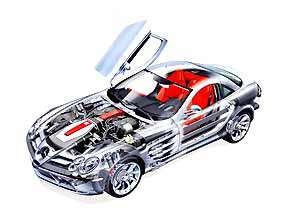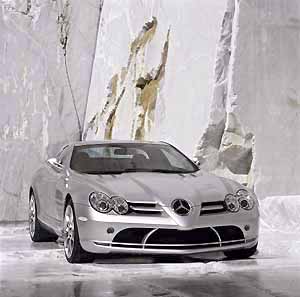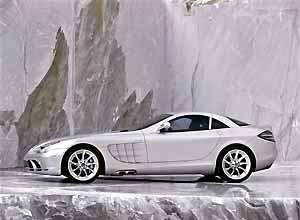
High-torque
V8 compressor engine with 460-kW/626-hp output

Drehmomentstarker V8-Kompressormotor mit 460 kW/626
PS |
Mercedes-Benz SLR McLaren
-
0 to 100 km/h in 3.8 seconds
-
World's first series-produced car to have carbon fibre front crash
structure
-
High-performance brake discs made from fibre-reinforced ceramic
 Stuttgart
- Back in the mid-1950s the three letters SLR acquired a hallowed status,
as a Mercedes-Benz racing car of that name set new standards in the world
of high-class Gran Turismo vehicles. Visually breathtaking and, thanks to
innovative technology, superior to its rivals in terms of performance and
handling, it spawned a legend. Mercedes-Benz and McLaren have successfully
imbued the new Mercedes-Benz SLR McLaren (due to make its debut in autumn
2003) with the same charismatic qualities. Just like its legendary predecessor
of 1955, this SLR incorporates new technological developments which are ahead
of their time. For evidence, simply take a glance under the bonnet at the
Mercedes-AMG V8 powerplant. With its 5.5-litre displacement and screw-type
compressor, the engine develops a peak output of 460 kW/626 hp
and delivers its maximum torque of 780 Newtonmetres from 3250 rpm
- a figure which remains constant across a broad engine speed range of up
to 5000 rpm. With this kind of power under the bonnet, the Mercedes-Benz
SLR McLaren delivers performance figures which are among the best in its
class: this high-performance sports car takes just 3.8 seconds to sprint
from 0 to 100 km/h, it passes the 200 km/h mark after
10.6 seconds, and from a standing start it takes just 28.8 seconds to
reach 300 km/h. The two-seater has a top speed of 334 km/h (provisional
figure). Stuttgart
- Back in the mid-1950s the three letters SLR acquired a hallowed status,
as a Mercedes-Benz racing car of that name set new standards in the world
of high-class Gran Turismo vehicles. Visually breathtaking and, thanks to
innovative technology, superior to its rivals in terms of performance and
handling, it spawned a legend. Mercedes-Benz and McLaren have successfully
imbued the new Mercedes-Benz SLR McLaren (due to make its debut in autumn
2003) with the same charismatic qualities. Just like its legendary predecessor
of 1955, this SLR incorporates new technological developments which are ahead
of their time. For evidence, simply take a glance under the bonnet at the
Mercedes-AMG V8 powerplant. With its 5.5-litre displacement and screw-type
compressor, the engine develops a peak output of 460 kW/626 hp
and delivers its maximum torque of 780 Newtonmetres from 3250 rpm
- a figure which remains constant across a broad engine speed range of up
to 5000 rpm. With this kind of power under the bonnet, the Mercedes-Benz
SLR McLaren delivers performance figures which are among the best in its
class: this high-performance sports car takes just 3.8 seconds to sprint
from 0 to 100 km/h, it passes the 200 km/h mark after
10.6 seconds, and from a standing start it takes just 28.8 seconds to
reach 300 km/h. The two-seater has a top speed of 334 km/h (provisional
figure).
In the interests of optimum weight distribution, optimum dynamic handling
and high stability on braking, the Mercedes-Benz SLR McLaren has a front
mid-engined design. The V8 powerplant is mounted on a robust aluminium frame
and has a low installation position. Water-type charge-air cooling, three
valves per cylinder, dry sump lubrication and four metal catalytic converters
are further special features of this powerful engine
- an engine which already meets stringent EU 4 exhaust
gas regulations which are not due to come into force until 2005.
Three transmission programs for short,
sporty gearshifts
The 5-speed automatic transmission, fitted as standard, is also designed
for high performance. It allows the driver to choose between three programs,
letting him or her determine the shift speed individually. When "Manual"
is selected, the five gears can either be shifted using buttons on the steering
wheel or using the selector lever's Touchshift function. In manual mode the
driver can select between three shift stages - "Sport", "SuperSport" and
"Race" - significantly shortening the shift times still further for an even
sportier drive.
High-tech material for exemplary safety
and outstanding rigidity
 The
bodyshell of the high-performance sports car is also distinctly high-tech.
Along with the front and rear structure and the passenger cell, the swing-wing
doors and the bonnet, it is made entirely from carbon fibre composite. This
lightweight yet extremely rigid material originated in the aeronautical and
space industries and has also proven its benefits in today's Formula 1 race
cars. The weight advantage of the high-tech material over steel is around
50 percent. In addition to this, carbon fibres, on impact, are characterised
by four to five times higher energy absorption than steel or aluminium.
Mercedes-Benz exploits these qualities by inserting two 620-millimetre
longitudinal members made from carbon fibre in the front structure of the
new SLR. These absorb the entire energy of the crash in a head-on collision
without exceeding tolerable deceleration values for the occupants. In an
impact the fibres of these elements shred from front to rear with precisely
calculated deformation behaviour, ensuring constant deceleration. This makes
the SLR the world's first series-produced car to have a front crash structure
made entirely from carbon fibre. The carbon fibre longitudinal members each
weigh just 3.4 kilograms. The passenger cell of the high-performance
sports car is also made entirely from this high-tech material. In a head-on,
side-on or rear-end collision, it offers the passengers an extremely rigid,
safe survival zone. At the rear, two internal longitudinal members made from
laminated carbon fibre and a robust cross member take on the task of energy
absorption in the event of a crash - as a rule the passenger
cell remains structurally unaffected. Adaptive front airbags which
deploy in two stages depending on the severity of the accident, newly developed
sidebags which protect the head, plus belt tensioners and belt force limiters
all form part of the new SLR's occupant protection system. The
bodyshell of the high-performance sports car is also distinctly high-tech.
Along with the front and rear structure and the passenger cell, the swing-wing
doors and the bonnet, it is made entirely from carbon fibre composite. This
lightweight yet extremely rigid material originated in the aeronautical and
space industries and has also proven its benefits in today's Formula 1 race
cars. The weight advantage of the high-tech material over steel is around
50 percent. In addition to this, carbon fibres, on impact, are characterised
by four to five times higher energy absorption than steel or aluminium.
Mercedes-Benz exploits these qualities by inserting two 620-millimetre
longitudinal members made from carbon fibre in the front structure of the
new SLR. These absorb the entire energy of the crash in a head-on collision
without exceeding tolerable deceleration values for the occupants. In an
impact the fibres of these elements shred from front to rear with precisely
calculated deformation behaviour, ensuring constant deceleration. This makes
the SLR the world's first series-produced car to have a front crash structure
made entirely from carbon fibre. The carbon fibre longitudinal members each
weigh just 3.4 kilograms. The passenger cell of the high-performance
sports car is also made entirely from this high-tech material. In a head-on,
side-on or rear-end collision, it offers the passengers an extremely rigid,
safe survival zone. At the rear, two internal longitudinal members made from
laminated carbon fibre and a robust cross member take on the task of energy
absorption in the event of a crash - as a rule the passenger
cell remains structurally unaffected. Adaptive front airbags which
deploy in two stages depending on the severity of the accident, newly developed
sidebags which protect the head, plus belt tensioners and belt force limiters
all form part of the new SLR's occupant protection system.
Ceramic brake discs and
SBCTM for exemplary braking safety
 The
brake discs of the cutting-edge swing-wing door vehicle are also made from
a high-tech material which meets the highest of standards. Here Mercedes-Benz
has used carbon fibre-reinforced ceramic to achieve outstanding performance,
temperature-resistance and longevity. Thanks to the highly robust material,
the SLR's large brake discs allow maximum deceleration of up to
1.3 g - a top value in a series-produced
car. At the front axle alone a total brake pad area of
440 cm2 is available. Further features of the new
SLR include Sensotronic Brake Control (the electrohydraulic braking system),
the Electronic Stability Program (ESP ®), automatic tyre pressure
monitoring, 18-inch wheels and aluminium suspension which bears the signature
of experienced race car constructors - all of which create the necessary
criteria for perfect dynamic handling and excellent driving safety. The
brake discs of the cutting-edge swing-wing door vehicle are also made from
a high-tech material which meets the highest of standards. Here Mercedes-Benz
has used carbon fibre-reinforced ceramic to achieve outstanding performance,
temperature-resistance and longevity. Thanks to the highly robust material,
the SLR's large brake discs allow maximum deceleration of up to
1.3 g - a top value in a series-produced
car. At the front axle alone a total brake pad area of
440 cm2 is available. Further features of the new
SLR include Sensotronic Brake Control (the electrohydraulic braking system),
the Electronic Stability Program (ESP ®), automatic tyre pressure
monitoring, 18-inch wheels and aluminium suspension which bears the signature
of experienced race car constructors - all of which create the necessary
criteria for perfect dynamic handling and excellent driving safety.
READER COMMENTS
| DaimlerChrysler Communications,
August 2003 |
BACK TO TOP
|
